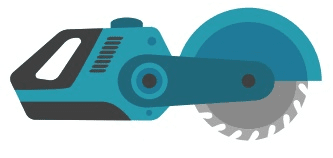How To Create An Awesome Instagram Video About Power Mitre Saw
The Ultimate Guide to Power Mitre Saws
A power mitre saw is a vital tool in any workshop, whether for professional carpenters, enthusiasts, or DIY lovers. Understood for their precision and performance, mitre saws can make fast and accurate crosscuts and mitre cuts, which are normally required for framing, moulding, and other woodworking tasks. This guide explores everything you need to know about power mitre saws, consisting of the different types, features to search for, maintenance suggestions, and responses to regularly asked concerns.
Understanding Power Mitre Saws
What Is a Mitre Saw?
A mitre saw, likewise understood as a chop saw, is a specialty saw utilized to make precise crosscuts and mitre cuts in a workpiece. The saw blade is mounted on a swing arm that rotates left or right to attain the preferred angle. This style permits for precise cutting of wood and other products at different angles, making it an important tool in woodworking.
Kinds Of Power Mitre Saws
There are several types of power mitre saws, each created for particular applications. Here's a breakdown of the most common types:
Type
Description
Best Uses
Requirement Mitre Saw
Offers fundamental mitre cutting abilities. Typically features a smaller sized blade (10” or 12” size).
Standard crosscuts and mitre cuts.
Compound Mitre Saw
Equipped with a blade that can tilt in one direction, enabling for compound cuts.
Crown moulding and angled cuts.
Sliding Compound Mitre Saw
Similar to a compound mitre saw but features a sliding mechanism for larger cuts.
Larger workpieces and in-depth work.
Dual-Bevel Mitre Saw
Can tilt both left and right, simplifying the process of making compound cuts.
Carpenters and professionals needing more flexibility.
Key Features to Look for in a Power Mitre Saw
When picking a power mitre saw, numerous crucial features ought to be considered to make sure that you select the ideal tool for your requirements:
- Blade Size: Common sizes consist of 10”, 12”, and 7.25” blades, with larger blades usually supplying much deeper cuts.
- Cutting Capacity: Check the maximum cutting width and height to guarantee it fits your tasks.
- Bevel Angles: The capability to cut at numerous bevel angles makes a mitre saw more versatile.
- Laser Guide: A laser guide can improve precision by offering a visual referral along the cutting course.
- Dust Collection: Good dust collection systems will assist keep a tidy work space and reduce clean-up time.
- Power Rating: Measure the power of the motor in amps; higher power rankings permit better performance in more difficult woods.
- Security Features: Look for features like blade guards, electric brakes, and security switches for improved user defense.
Benefits of Using a Power Mitre Saw
Power mitre saws are favored in woodworking for a number of factors:
- Precision: The design enables constant cuts, vital for projects requiring tight tolerances.
- Performance: Cuts can typically be made faster than with hand saws or other tools.
- Reduce of Use: Many designs are created for uncomplicated operation, making them available for users of numerous skill levels.
- Flexibility: With different cutting angles and capacities, mitre saws can handle a broad array of jobs.
Upkeep Tips for Power Mitre Saws
To keep your power mitre saw and guarantee ideal efficiency, try to find the following maintenance practices:
- Regular Cleaning: Keep the blade and the saw body clean from sawdust to ensure it runs efficiently.
- Blade Maintenance: Inspect blades for damage and change them as required. A dull blade can cause poor cuts.
- Check Alignment: Ensure the blade is lined up correctly to the fence and base for accurate cuts.
- Lubrication: Check and lube moving parts periodically to avoid wear and tear.
- Safe Storage: Store the saw in a dry, cool area to avoid rust and damage to electrical parts.
Frequently Asked Questions (FAQ)
1. What is the difference in between a single bevel and a double bevel mitre saw?
A single bevel saw can just tilt in one direction, while a dual bevel saw can tilt both to the left and right. This feature enables much easier compound cuts without requiring to flip the workpiece.
2. Best Mitre Saw UK saw cut through metal?
Standard mitre saws are primarily designed for wood. While there are specific blades designed for cutting metal, it's generally suggested to utilize a dedicated metal cutting saw for the best outcomes.
3. How do I know what blade to use for my mitre saw?
The blade type depends upon the product you are cutting. Wood blades generally have fewer teeth (around 24-40), while finish blades for woods have more teeth (60-80). For various products, try to find blades designed specifically for those applications.
4. Can I utilize my mitre saw for ripping lumber?
Mitre saws are not created for ripping wood. They master crosscutting and angle cuts. For ripping, a table saw is the better tool.
5. How often should I replace the blade on my mitre saw?
Blade replacement frequency depends on the quantity and type of work you do, as well as the products being cut. A general rule is to replace a blade when you notice it ending up being dull or if you are beginning to see burn marks on your cuts.
Power mitre saws are important tools for anyone dealing with wood. From basic crosscuts to complex compound angles, these saws supply the precision, effectiveness, and flexibility required for a large variety of woodworking projects. By understanding the various types available, essential functions to consider, and how to keep the saw, users can maximize their financial investment in this necessary tool. Whether you're an experienced professional or a passionate novice, accepting the power of a mitre saw can elevate your woodworking abilities significantly.
